pbertner
TPF Noob!
- Joined
- Sep 30, 2010
- Messages
- 12
- Reaction score
- 0
- Can others edit my Photos
- Photos NOT OK to edit
How even the bright harvestmen are able to blend in (Yellow Gonyleptid harvestman):
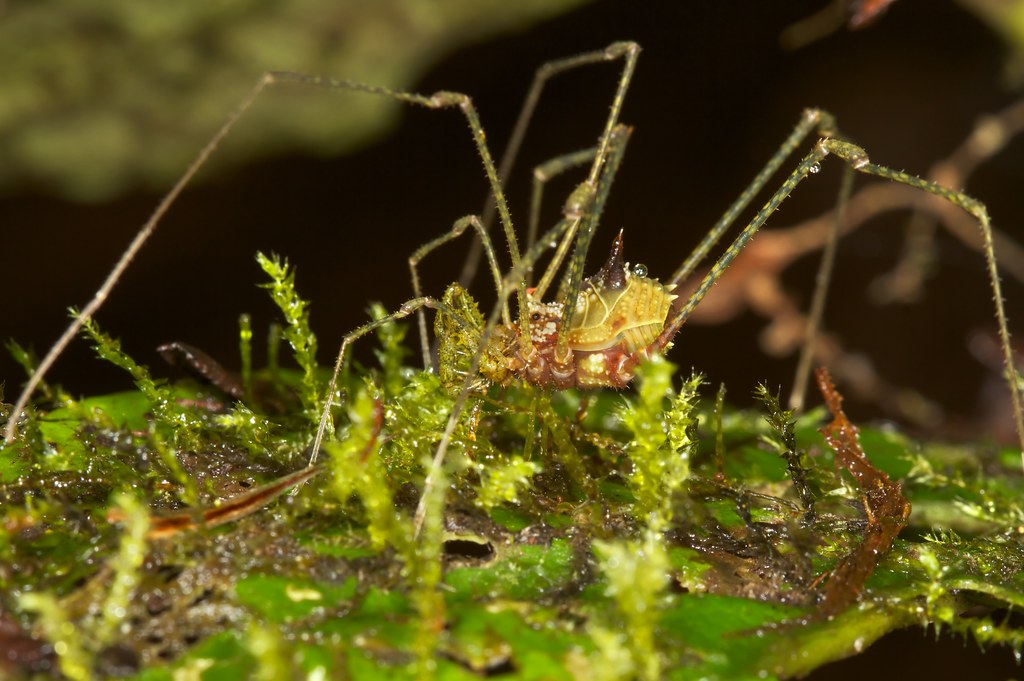
"ahem...wait I think I've got something in my palps...oh how embarrassing"

under uv light:
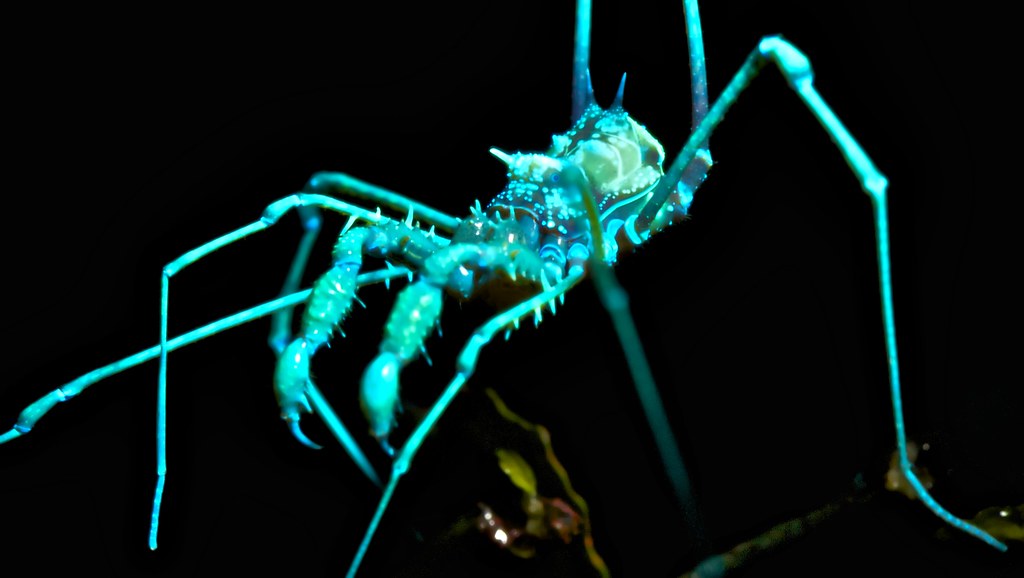
Thanks to Techuser on flickr for the idea of using UV on harvestmen. Here shows the use of a tripod using 15 and 30 second long exposures, while minimizing ISO's to 100-400. The results are much cleaner than previous attempts. Here, any movement will result in fairly poor results. UV light was in the 365nm wavelength. This provides a more naturalistic lighting that minimizes the purple colour cast of 400nm + wavelengths, though the latter definitely have an interesting look. Furthermore this wavelength seems to make create a brighter fluorescence, enabling shorter exposure times. The reason is a little unclear though. Some insects see in UV and so it might help in species differentiation or mate selection. Snakes, birds and other predators can also see in UV so perhaps the brightness reflects aposematism in nocturnal predators in a similar way to how bright colours in the visible spectrum do to diurnal predators. Harvestmen use a variety of defenses including aposematism, stridulation and chemical defenses to ward off predators and so it seems feasible that such fluorescence might fulfill a similar role. Though the accentuation of patterns on the dorsum and posterior might be more reflective of mate selection since many harvestmen will perch up high and with relatively poor vision, such brightness might help them find a mate.
Some other insects that I have found to reflect UV are some leaf mimicking katydids, centipedes (Scolopendra), some crab backed orbweavers (Micrathena sp.), some caterpillars, scorpions, some stick insects, some grasshoppers/katydids...quite a broad spectrum really. Though like mimetism UV fluorescence seems to change with the life cycle, either becoming stronger of weaker with age depending on the species. For example one individual of a possible new genus of millipede that I found fluoresced red under UV. But others didn't.
Eyes in the back of your...abdomen?
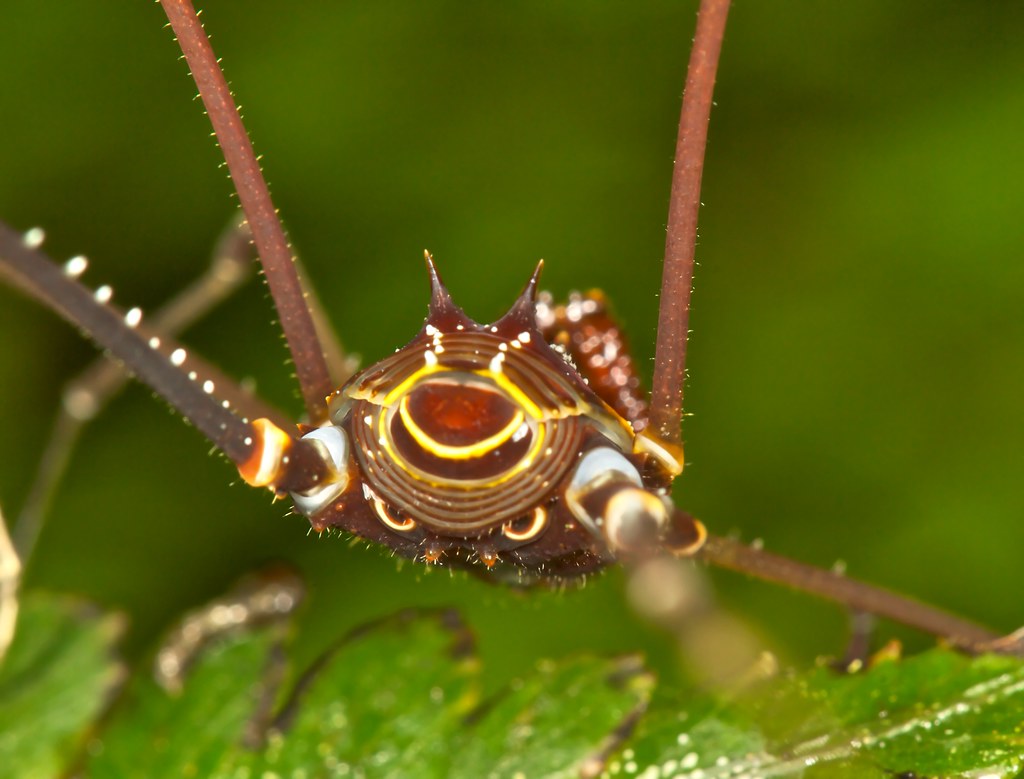
Parental care in cosmetid harvestmen:
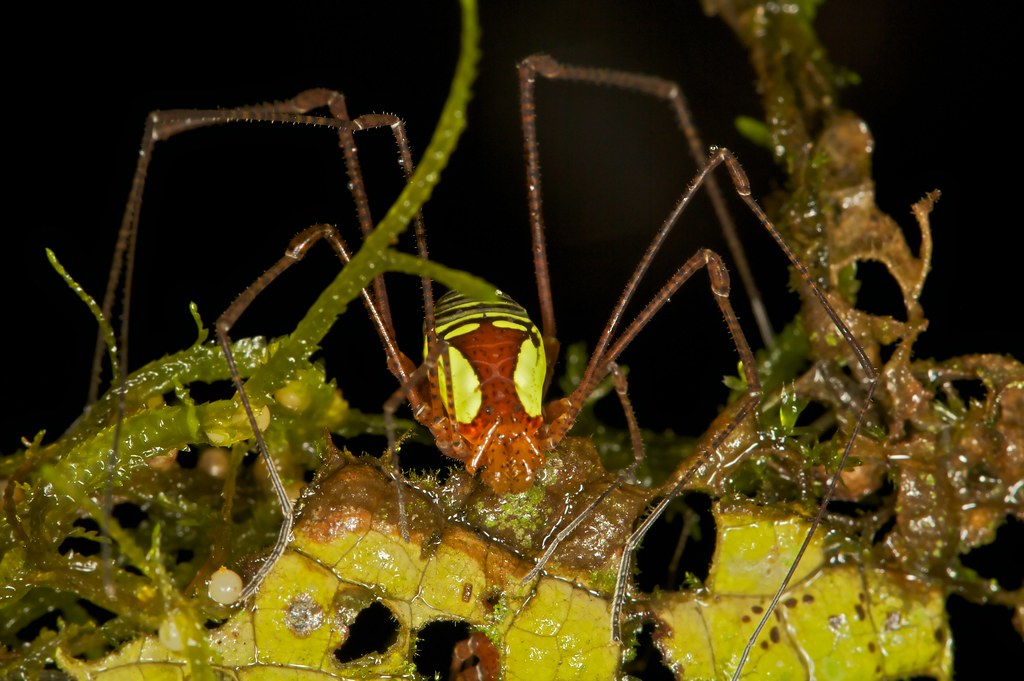

Though it is usually the female that guards the eggs, in some species there may be a gender reversal. Parental care takes several forms including though not limited to cryptic egg deposition, transportation of young, guarding and cleaning of eggs [http://www.jstor.org/pss/25067826]. Both male and female were seen hovering around the eggs. In these particular harvestmen I saw on several occasions eggs that were deposited in mosses that hung from branches. This strategic position ensures that the eggs are off the ground and away from most fungi and microbiological attack, while also allowing for a single entry point to the eggs. Predators that do find the eggs can hopefully be dealt with by the parents by knocking them off their perch and back down to the forest floor, instead of grappling with them in a struggle which if it doesn't kill them, might limit their future ability to protect their eggs. Or else, they can spray a noxious chemical mixture composed of mostly quinones from scent glands (ozopores).
The foot tarsus which is extremely dexterous is constantly touching and probing the eggs due in part to the poor eyesight of harvestmen, requiring the use of a more tactile sense to ensure the safety and survival of its brood. The sensitive slit sensillae might also be able to pick up abnormalities in the eggs such as fungi , mould or the beginnings of putrefaction by bacteria. This sensitivity is especially important given the incredibly humid environment of the cloud rainforest. Eggs are regularly cleaned by being taken into the mouthparts and given a thorough rasping with the pedipalps to remove any physical adherents (which help grow bacteria and moulds), not to mention addition of antibiotic/antifungal fluids from the saliva. Failing this, decaying eggs are removed so that they do not contaminate the rest of the clutch. Eggs make for a very nutritious and balanced diet for many animals and insects since they are required to have all of the nutrients necessary for the growth of the embryo into a hatchling. Because eggs are generally defenseless, they are also taken by a wide variety of predators, including marauding cannibalistic members of the same species. Constant hovering of the feet over the eggs may then help dissuade small predators from seeking an otherwise easy meal.
Cosmetid harvestman:
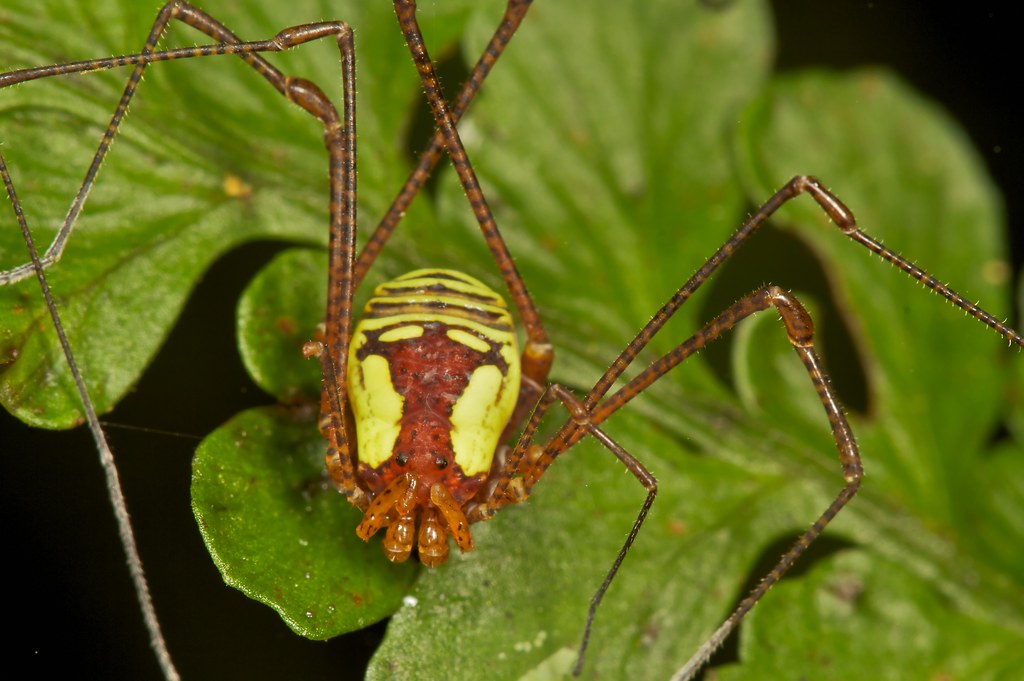
under UV:
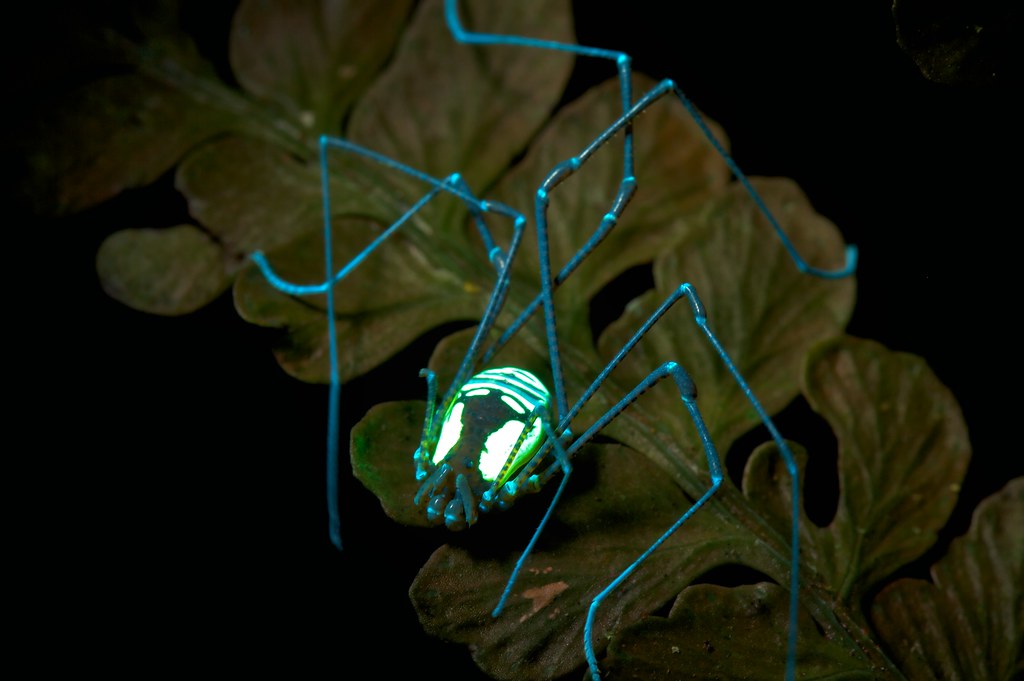
Thanks for looking and commenting,
Paul

"ahem...wait I think I've got something in my palps...oh how embarrassing"

under uv light:

Thanks to Techuser on flickr for the idea of using UV on harvestmen. Here shows the use of a tripod using 15 and 30 second long exposures, while minimizing ISO's to 100-400. The results are much cleaner than previous attempts. Here, any movement will result in fairly poor results. UV light was in the 365nm wavelength. This provides a more naturalistic lighting that minimizes the purple colour cast of 400nm + wavelengths, though the latter definitely have an interesting look. Furthermore this wavelength seems to make create a brighter fluorescence, enabling shorter exposure times. The reason is a little unclear though. Some insects see in UV and so it might help in species differentiation or mate selection. Snakes, birds and other predators can also see in UV so perhaps the brightness reflects aposematism in nocturnal predators in a similar way to how bright colours in the visible spectrum do to diurnal predators. Harvestmen use a variety of defenses including aposematism, stridulation and chemical defenses to ward off predators and so it seems feasible that such fluorescence might fulfill a similar role. Though the accentuation of patterns on the dorsum and posterior might be more reflective of mate selection since many harvestmen will perch up high and with relatively poor vision, such brightness might help them find a mate.
Some other insects that I have found to reflect UV are some leaf mimicking katydids, centipedes (Scolopendra), some crab backed orbweavers (Micrathena sp.), some caterpillars, scorpions, some stick insects, some grasshoppers/katydids...quite a broad spectrum really. Though like mimetism UV fluorescence seems to change with the life cycle, either becoming stronger of weaker with age depending on the species. For example one individual of a possible new genus of millipede that I found fluoresced red under UV. But others didn't.
Eyes in the back of your...abdomen?

Parental care in cosmetid harvestmen:


Though it is usually the female that guards the eggs, in some species there may be a gender reversal. Parental care takes several forms including though not limited to cryptic egg deposition, transportation of young, guarding and cleaning of eggs [http://www.jstor.org/pss/25067826]. Both male and female were seen hovering around the eggs. In these particular harvestmen I saw on several occasions eggs that were deposited in mosses that hung from branches. This strategic position ensures that the eggs are off the ground and away from most fungi and microbiological attack, while also allowing for a single entry point to the eggs. Predators that do find the eggs can hopefully be dealt with by the parents by knocking them off their perch and back down to the forest floor, instead of grappling with them in a struggle which if it doesn't kill them, might limit their future ability to protect their eggs. Or else, they can spray a noxious chemical mixture composed of mostly quinones from scent glands (ozopores).
The foot tarsus which is extremely dexterous is constantly touching and probing the eggs due in part to the poor eyesight of harvestmen, requiring the use of a more tactile sense to ensure the safety and survival of its brood. The sensitive slit sensillae might also be able to pick up abnormalities in the eggs such as fungi , mould or the beginnings of putrefaction by bacteria. This sensitivity is especially important given the incredibly humid environment of the cloud rainforest. Eggs are regularly cleaned by being taken into the mouthparts and given a thorough rasping with the pedipalps to remove any physical adherents (which help grow bacteria and moulds), not to mention addition of antibiotic/antifungal fluids from the saliva. Failing this, decaying eggs are removed so that they do not contaminate the rest of the clutch. Eggs make for a very nutritious and balanced diet for many animals and insects since they are required to have all of the nutrients necessary for the growth of the embryo into a hatchling. Because eggs are generally defenseless, they are also taken by a wide variety of predators, including marauding cannibalistic members of the same species. Constant hovering of the feet over the eggs may then help dissuade small predators from seeking an otherwise easy meal.
Cosmetid harvestman:

under UV:

Thanks for looking and commenting,
Paul












![[No title]](/data/xfmg/thumbnail/42/42268-15c1c02cec1d71208987fc7c7ec7784c.jpg?1734176663)